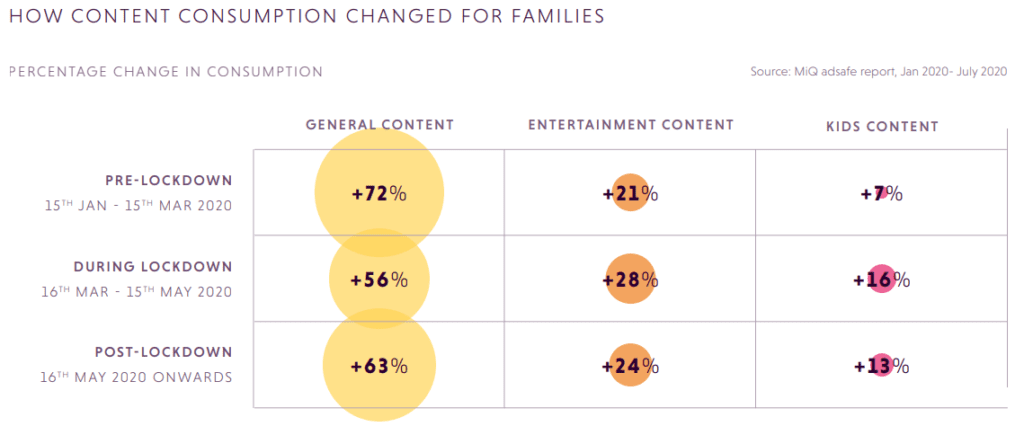|
Getting your Trinity Audio player ready...
|
“There’s no doubt that the lockdown measures introduced to combat the spread of COVID-19 have had a demonstrable and lasting effect on consumers,” according to a new whitepaper by programmatic media specialist MiQ.
The whitepaper, How Covid-19 changed the UK consumers, looks into how the pandemic has altered content consumption and the changes that will have a lasting impact on consumer behaviour. The findings can help publishers formulate more effective content, distribution, advertising and eCommerce strategies for UK audiences.
It is divided into two parts. The first presents the big trends arising out of the pandemic. The second part looks into how COVID-19 has reshaped consumers.
It identifies four dominant types of users in the UK based on the online activities of a sample of 4.6M people before, during and after the initial lockdown (from late March to late May 2020).
“New skills and hobbies will redefine them as consumers”
The big trends observed among the UK audience during Covid-19 lockdowns and social distancing are:
- Internet consumption spiked during the lockdown: There was an explosion in content consumption across devices as people stayed at homes. News consumption soared, interest in online games and food and drink-related content also increased.
- Covid-19 accelerated digital trends among older people: The study notes an increase in online shopping across age groups. But the most dramatic rise was seen in consumers aged 55 and over. Their intent to shop online almost doubled after the initial March lockdown started. This is a lasting change, according to a McKinsey study referred to in the whitepaper which found that people expected to shop online more post-lockdown.
- Self-improvement became a major focus: There has been a rise in interest in self-improvement. It is led by the 18-35 year age group, followed by those who are 45 and older. The most popular topics have been continuing education and workforce training.
Lots of people have used the lockdown to learn new things – and their new skills and hobbies will redefine them as consumers once lockdown and social distancing are over.
How Covid-19 changed the UK consumers
“Staggering increase in mobile consumption”
The dominant user types identified by the study are:
- News junkies (36% of total sample size)
- Super fit (27%)
- Self-improvers (19%)
- Family first (18%)
News junkies read more than 62 news articles a week on average. Topics consumed range from local and global politics, to international news and current affairs, to lifestyle and sports. The study found that older news junkies, particularly those aged 35 to 54, tend to focus on global political and financial news. Those aged 55 and over tend to have the broadest interests when it comes to the categories of news they read.
An important change of habit among news junkies is in their consumption timings. While they were avid news readers before the pandemic as well, they would generally catch up with it in the morning. During lockdown they spent more time reading the news throughout the day.
News junkies primarily use PCs and laptops to access news, but the study notes a “staggering increase in mobile consumption over the past six months.”
The Super fit audience comprises primarily women (2/3rds). However, men in this group engage with more content on the whole. They were not limited to looking for ways to get fit or stay in shape, but branched out into home cooking and healthy eating. They were also the most active online shoppers through the March-May lockdown and demonstrated interest in fashion and fitness apparel.
“Consumers in this group are nearly 2x more likely to do research online before making a purchase,” according to the whitepaper. This opens up opportunities for publishers to serve fitness-related content as well as drive revenue from eCommerce and ads.
Two thirds of the people in this segment have an annual household income between £75k and £125k, and people in this category generally have a high likelihood to be trendsetters.
How Covid-19 changed the UK consumers
Self-improvers have used the lockdown period to develop their skills or learn something new. These could include professional training for career, hobbies like gardening or cooking, or financial investment planning for a better future.
Younger people (18-34) in this category were engaged in activities that included both professional development and hobbies. Older groups (35 to 54) tended to focus on understanding of finance and investment management and upgrading their professional skills. The oldest (55+) focused on rediscovering hobbies like gardening, cooking, or playing musical instruments.
60% of the self-improvers learnt two or more new skills during the lockdown.
The new skills that self-improvers learn will redefine them as consumers. They will be thinking about new things, often buying things they’ve never bought before as their knowledge and experience in a new hobby deepens, as well spending more time on websites and apps they’ve previously never visited.
How Covid-19 changed the UK consumers
The Family-first segment is made up of people who are either married or in a relationship (63%), and nearly half have at least one child in their household. This group has shown the lowest levels of digital activity as their time was more devoted to other members of the household.
Those with kids have had to juggle multiple roles including that of playmate, teacher, entertainer, and caretaker. Thus their digital consumption includes more entertainment and educational content directed at children compared to the other groups.
Interest in educational content for kids increased 81% in this group. Video consumption on YouTube for Kids jumped almost 300% when schools closed at the beginning of the pandemic. It has continued to be almost 200% higher compared to pre-lockdown levels.
“These four clusters are among the most identifiable groups with new digital habits, but most consumers now have a new relationship with online shopping, research, learning and entertainment,” the authors write.
This gives publishers new ways to learn about and reach their audience. More people are online, including older audiences, and they are increasingly looking for content that will help them with personal development as well as solve day-to-day problems.
Those who have taken up new hobbies and learned new skills during the lockdown would likely continue to look for content that helps them continue with their new habits. Similarly, publishers may benefit from tailoring their content to serve the “staggering increase in mobile consumption.” Catering to these new needs would help publishers build engagement and loyalty in the long run.
Though we don’t know exactly when we’ll be back to ‘normal’ life, we can be fairly certain that many of these changes will have a lasting effect on the way consumers behave, work, relax and buy.
How Covid-19 changed the UK consumers









